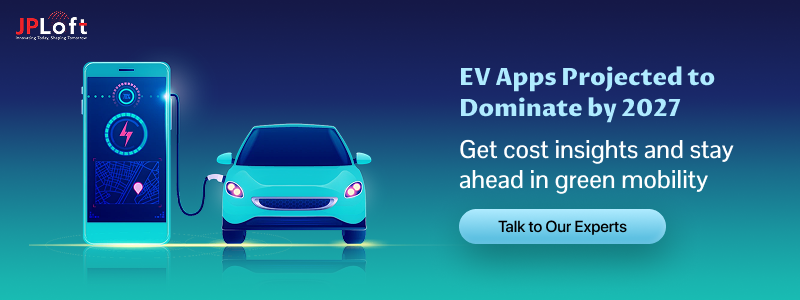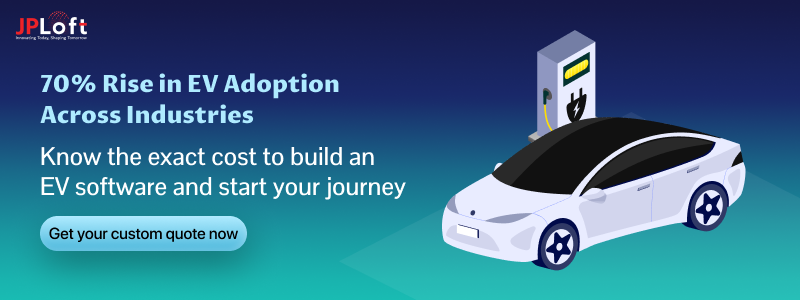“The global shift to electric vehicles is inevitable and essential.” – Bill Gates, Co-founder of Microsoft
The quote reflects how the EV revolution is now a present reality. According to a recent report, electric vehicle (EV) sales have crossed 22.1 million in the third quarter of 2025, with a projected sales of 40.7 million by 2030.
But here comes the big question for automakers, startups, and mobility service providers:
How much does it cost to build an EV software?
The cost typically ranges from $50,000 to $300,000+, depending on its complexity, features, and development approach.
In this blog, we’ll break down everything from development timelines to pricing factors and cost-saving tips, so you can make informed decisions before you invest.
Key Takeaways:
Cost to build an EV software depends on features, tech stack, and team location. Basic apps start at $50,000; advanced solutions can exceed $300,000+.
Basic features are affordable, but AI, diagnostics, and fleet tools significantly increase cost and time.
Using cross-platform tools, open-source components, and offshore teams can cut the cost to develop an Electric Vehicle software. Start learning with an MVP.
Revenue can come from subscriptions, data use, in-app purchases, or charging network partnerships.
Budget 15–20% annually for hosting, updates, and compliance to keep your app competitive.
From ideation to launch, JPLoft delivers performance-driven EV apps that are future-ready and cost-optimized.
What is Electric Vehicle Software?
Electric Vehicle (EV) software is the intelligent system that controls, monitors, and enhances the performance of electric vehicles.
Unlike traditional cars that rely heavily on mechanical parts, EVs depend on software to handle everything from battery management and navigation to diagnostics, charging, and user interaction.
It’s helping drivers find the nearest charging station, monitoring battery health, or enabling smartphone connectivity, EV software plays a central role in delivering a smart and seamless experience.
It allows remote access, real-time data tracking, and smooth integration with third-party platforms, making the vehicle not just electric, but connected and intelligent. As the demand for electric vehicles continues to rise, companies aiming to enter this market need to develop EV software that is scalable, secure, and user-friendly.
A well-designed software solution can significantly improve the efficiency of EV operations, offer valuable insights, and enhance the overall user experience.
Cost to Build an Electric Vehicle Software in 2025
How much does it cost to build an electric vehicle software? The answer depends on several factors, including the complexity of features, UI/UX design, platform compatibility, integrations, and the location and expertise of your development team.
On average, the cost to create an EV software typically falls between $50,000 to $300,000+.
This cost range covers everything from a basic EV app with limited features to a high-end software system with real-time diagnostics, smart charging capabilities, IoT integration, fleet tracking, and cloud-based data analytics.
The broader the functionality and the smarter the system, the higher the investment required. For many startups and mobility businesses, understanding EV app development pricing early in the planning stage is critical.
Here’s a clear EV software development cost breakdown to help you estimate your investment based on your project’s complexity.
|
Development Level |
Features Included |
Estimated Cost |
|
Basic |
Simple UI, battery status, static data, single-platform support |
$50,000 – $80,000 |
|
Moderate |
Real-time data, GPS, charging station integration, basic analytics, multi-platform |
$80,000 – $150,000 |
|
Advanced |
Smart diagnostics, AI-based analytics, cloud sync, IoT, fleet tools, scalability |
$150,000 – $300,000+ |
As shown above, the average cost of EV software development increases with feature complexity and scalability requirements.
Since the cost to create an app varies significantly based on what you include, it's important to align your features with business goals and user needs.
Investing wisely in the right development level ensures your EV software is both functional and future-ready.
Key Factors That Influence the EV Software Development Cost
Now, it's time to answer one of the biggest questions that comes to mind when you’re thinking about EV software in 2025: How much does it cost to build an EV software in 2025?
The cost to create an EV software can vary significantly based on several core elements, from feature set and tech stack to platform and location.
This section breaks down the EV software development cost factor-by-factor to help you make smart, budget-conscious decisions.
1. Type of EV Software You’re Building
The cost to develop an EV software largely depends on what you're building.
A basic driver app with route tracking is far less complex than a full fleet management system with real-time analytics and charging integration.
If you’re working on unique EV app ideas, keep in mind that more advanced features add to both complexity and overall cost.
Mention different types of EV software explain them in para description, mention cost and one example
-
Basic EV app: It is a simple application focused on navigation, nearby charging stations, and battery monitoring. Ideal for individual EV users. The estimated cost could range between $15,000–$30,000.
Example: PlugShare, it helps users locate charging stations.
-
EV Fleet Management Software: EV Fleet Management Software: This software is built for logistics and transport companies managing a fleet of electric vehicles. It includes real-time tracking, performance analytics, maintenance alerts, route planning, and driver behavior monitoring. The cost to build an EV fleet management app typically fall between $50,000–$100,000+.
Example: Geotab, it offers EV fleet optimization solutions.
-
EV Management System: An EV management system lets businesses monitor and control their electric vehicles, charging stations, and energy usage from a single dashboard. Costs usually vary between $40,000 to $90,000.
Example: EV Connect, it helps smart EV management solutions for businesses and utilities.
|
Type of Software |
Cost Impact |
Description |
|
Basic EV App |
Medium |
Charging locator, basic UI, static data |
|
EV Management System |
High |
Real-time monitoring, smart charging, remote diagnostics |
|
EV Fleet Management Software |
Very High |
Telematics, AI-based analytics, route optimization, multi-vehicle control |
The EV fleet management software cost can be especially high due to the complexity and volume of data handled.
2. Features & Functionalities
The richer the feature set, the higher the electric vehicle software development cost. Core features like real-time battery status, location tracking, and smart charging are a must.
But advanced features like AI, predictive maintenance, and telematics can significantly impact your EV app development pricing.
The overall cost depends heavily on the features of EV apps you choose to include.
Planning features based on user needs and long-term scalability is crucial for staying within budget.
- Basic Features: Includes user registration, vehicle tracking, battery status, and nearby charging station finder.
Cost: Around $15,000 – $30,000
- Moderate Features: Adds smart charging, route optimization, maintenance alerts, and payment integration.
Cost: Typically ranges from $30,000 – $60,000
- Advanced Features: Covers AI-based driving insights, predictive maintenance, telematics, remote diagnostics, and fleet analytics.
Cost: Can go from $60,000 to $120,000+
|
Features Level |
Cost Impact |
Description |
|
Basic Features |
Medium |
Battery display, charging status, GPS |
|
Moderate Features |
High |
Remote control, OTA updates, scheduling |
|
Advanced Features |
Very High |
AI, smart diagnostics, multi-device support, cloud sync |
Prioritizing features based on user needs helps manage the budget to build EV management software effectively.
3. UI/UX Design Complexity
The EV app design plays a huge role in your software's usability and appeal. A simple design with pre-made components is cheaper, while a custom, interactive interface will drive up the pricing for EV software development.
The process usually starts with wireframing, where the layout and user flow are mapped out. Next comes prototyping, allowing stakeholders to visualize functionality before actual development begins. The more intuitive and polished the UI/UX, the more time and cost it adds to the project.
The overall design cost depends on whether you go for a basic layout or invest in a custom interface. Here’s a quick breakdown:
Basic Design
-
Number of Screens: Limited screens, using standard layouts. The cost could be $50–$100 per screen.
-
Design Revisions: Minimal feedback loops (1–2 rounds). Cost can fall between $200–$300 per revision.
-
Responsive Design: Basic adaptation for mobile only. Can add ~15% to overall design cost.
-
Design Tools & Prototyping Platforms: Basic use of tools like Figma (free tier or minimal cost). Approximate cost range can be $100–$200.
Custom Design
-
Number of Screens: Multiple custom-designed screens with unique layouts. Estimated cost can fall between $100–$150 per screen.
-
Design Revisions: Multiple feedback and iteration cycles. Likely cost range $300–$500 per revision cycle
-
Custom Animations & Micro-Interactions: It has high-end interactive design features. The budget range could be $500–$2,000+
-
Responsive Design: Optimized for mobile, tablet, and desktop views. Can add 20–30% to overall design cost
-
Design Tools & Prototyping Platforms: Use of premium tools/plugins (e.g., Adobe XD, InVision). Approximate cost range could be between $200–$500.
|
Design Type |
Cost Impact |
Description |
|
Basic Design |
Low |
Uses templates or UI kits |
|
Custom Design |
Medium–High |
Unique branding, animations, and tailored user journeys |
Even though custom design increases the cost to make an EV software, it adds long-term brand value.
4. Platform Choice (Web, iOS, Android, or All)
The platform(s) you target directly affect the cost to build an electric vehicle software. A native app for one OS costs less than building for both iOS and Android. Web dashboards for management add another layer.
If your audience is primarily on Apple devices, you may hire iOS app developers to build a sleek, high-performance app. However, targeting all platforms ensures wider reach but also increases development time and cost.
Let’s discuss it in detail.
-
Single Platform
This approach involves building for only one platform, either Android, iOS, or Web.
It's ideal for startups or MVPs with a clear target audience (for example, Android users).
The biggest advantage is lower cost and faster development, as the team can focus on one environment.
Estimated Cost: Android or iOS App: $12,000 – $25,000
Web Dashboard: $10,000 – $20,000
- Cross-Platform
Cross-platform development uses frameworks like Flutter or React Native to build a single codebase that runs on both Android and iOS.
It suits businesses that want to launch quickly on both platforms while saving money.
Estimated Cost: Cross-Platform App (iOS + Android): $20,000 – $35,000
- Native Platform (iOS & Android Separately)
Native apps are built separately using platform-specific technologies, Swift for iOS and Kotlin/Java for Android.
This method is best when performance, scalability, or deep native integration is required.
Estimated Cost: iOS App: $15,000 – $30,000
Android App: $12,000 – $25,000
Combined Native (Both): $30,000 – $50,000+
- All Platforms (Web + Android + iOS)
This full-suite approach covers mobile apps for both platforms and a web dashboard for admins or fleet operators.
It’s ideal for growing or large-scale EV businesses looking for a seamless digital ecosystem.
While it maximizes user reach and operational control, it’s also the most expensive and complex option.
Estimated Cost: All Platforms (Full Suite): $35,000 – $60,000+
|
Platform |
Cost Impact |
Description |
|
Single Platform |
Medium |
Android or iOS only |
|
Cross-Platform |
Medium–High |
Developed with Flutter/React Native for wider coverage |
|
Native Platform |
High |
Separate apps for iOS and Android with dedicated codebases |
|
All Platforms |
Very High |
Includes iOS, Android, and web dashboard for full coverage |
Selecting the right platform combination helps control the estimated cost to develop an electric vehicle software early on.
5. Development Team Location
Where your development team is based plays a big role in the EV software development cost. Outsourcing to regions like India or Eastern Europe offers the same quality at lower rates compared to the US or UK.
If you prefer working with a local mobile app development company in Denver, be prepared for higher hourly rates, but with the benefit of real-time collaboration, cultural alignment, and easier communication.
You can choose to hire freelancers, agencies, or established development companies, each option comes with different cost implications.
-
Freelancers may offer the most budget-friendly rates. It starts as low as $15–$40/hour, especially in countries like India or Eastern Europe. However, the trade-offs can include communication gaps, inconsistent quality, or limited scalability.
-
Established App Development Companies offer the highest reliability, end-to-end support, dedicated QA, and post-launch services. Rates typically range between $100–$200+/hour, especially in regions like the US, UK, or Australia.
While freelancers may seem attractive for cost-cutting, hiring experienced developers from a reputed agency or company like JPLoft is strongly recommended.
It makes your development journey smoother, minimizes risks, and ensures professional delivery aligned with your business goals.
|
Region |
Hourly Rate |
Cost Impact |
|
USA/UK |
$100–$180/hr |
High |
|
Western Europe |
$80–$150/hr |
High |
|
Eastern Europe |
$40–$70/hr |
Medium |
|
India/South Asia |
$25–$50/hr |
Low |
A smart outsourcing decision can significantly reduce the cost to create an electric vehicle software without sacrificing quality.
6. Technology Stack
The technology stack forms the technical foundation of your EV software. It includes everything from the tools used to build the app interface to the frameworks and infrastructure that support backend operations, database storage, and seamless deployment.
Choosing the right stack directly influences your app’s performance, scalability, maintainability and of course, your overall cost to build an EV software.
Key Components of a Technology Stack:
- Frontend (Mobile & Web): This is what users interact with, your app’s interface. Mobile apps can be built using Flutter or React Native for cross-platform compatibility or with Swift (iOS) and Kotlin (Android) for native performance. For web dashboards or admin panels, React.js, Angular, or Vue.js are commonly used.
Cost Estimate: $5,000 – $20,000 depending on platform and design complexity
- Backend Development: The server-side logic handles data processing, user authentication, API connections, and business logic. Popular choices include Node.js, Python (Django or Flask), and Java Spring Boot.
Cost Estimate: $8,000 – $25,000 based on architecture and scalability
- Database: For storing user data, vehicle information, payments, and historical logs, solutions like PostgreSQL, MongoDB, and MySQL are widely used. The choice depends on whether your app needs structured or flexible data models.
Cost Estimate: $2,000 – $5,000 for setup and integration
- Cloud Infrastructure: Services like AWS, Google Cloud, or Microsoft Azure help host your application, store data, and scale as user demand grows. These platforms offer robust security and uptime guarantees.
Cost Estimate: $100 – $500/month depending on usage and traffic
- DevOps Tools: For seamless deployment, code versioning, and automated testing, tools like Docker, Kubernetes, Jenkins, and GitHub Actions are essential. They reduce human errors and accelerate releases.
Cost Estimate: $3,000 – $8,000 for configuration and maintenance
- Third-Party APIs & SDKs: These are used for adding functionalities like payment gateways (Stripe, Razorpay, PayPal), maps & geolocation (Google Maps API), SMS/email notifications (Twilio, Firebase), and analytics.
Cost Estimate: $50 – $300/month based on providers and usage
|
Layer |
Technologies Used |
Purpose |
|
Frontend (Mobile) |
Flutter, React Native, Swift (iOS), Kotlin (Android) |
UI development for native or cross-platform apps |
|
Frontend (Web) |
React.js, Angular, Vue.js |
Admin dashboards, customer portals |
|
Backend |
Node.js, Python (Django/Flask), Java Spring Boot |
Business logic, API handling, real-time processing |
|
Database |
PostgreSQL, MongoDB, MySQL |
Data storage – trips, users, payments, vehicle data |
|
Cloud |
AWS, Google Cloud, Microsoft Azure |
Hosting, scalability, and cloud functions |
|
DevOps |
Docker, Kubernetes, Jenkins, GitHub Actions |
CI/CD pipelines, automated deployments |
|
APIs/SDKs |
Google Maps API, Stripe/PayPal, Twilio, Firebase |
Location tracking, payment, communication, push notifications |
7. Advanced Technologies
In today’s competitive EV ecosystem, adding advanced technologies can dramatically elevate your product’s value, customer experience, and operational efficiency.
These features are not essential for MVPs (minimum viable products), but they help position your brand as future-ready and intelligent.
To build and implement such technologies seamlessly, it’s often best to hire dedicated developers who specialize in AI, IoT, and EV-specific software capabilities. Their expertise ensures your app is not only functional but also scalable and tech-forward.
Below is the detailed analysis of high-end technologies that boost functionality.
- AI-Powered Route Optimization: AI in electric vehicles uses traffic patterns, battery range, charging station availability, and terrain data to suggest the most efficient routes for electric vehicles. Great for fleet apps or long-distance EV travel.
Cost Estimate: $3,000 – $10,000 depending on algorithm complexity and data sources
- IoT Integration: Syncs your software with in-vehicle sensors to track data like battery temperature, tire pressure, location, and performance metrics in real time. It adds a smart, connected layer to your platform.
Cost Estimate: $5,000 – $15,000 based on number of data points and hardware integration
- EV Battery Management System (BMS): Monitors charging cycles, battery degradation, voltage levels, and alerts users on battery health. Critical for apps designed for EV fleet management or charging networks.
Cost Estimate: $4,000 – $12,000 depending on the battery model and monitoring granularity
- Vehicle Telematics: Provides real-time insights into vehicle behavior, trip history, speed monitoring, and maintenance status. Often used in B2B fleet platforms for compliance and safety.
Cost Estimate: $5,000 – $20,000 depending on analytics depth and UI visualizations
- Predictive Maintenance Using AI: Uses machine learning to forecast mechanical failures, worn-out components, or upcoming service needs, thus reducing downtime and operational costs.
Cost Estimate: $5,000 – $15,000 depending on historical data availability and ML model complexity
- Remote Diagnostics: Enables remote issue detection and diagnostics without needing a physical service center visit. Often integrated with IoT and BMS for full-stack visibility.
Cost Estimate: $3,000 – $10,000 based on diagnostic capabilities and error resolution systems
- Voice Assistant Integration: Add voice commands to your app for tasks like checking battery status, locating chargers, or scheduling service appointments. Works well with in-car infotainment systems.
Cost Estimate: $2,000 – $7,000 depending on language support and third-party SDKs
|
Technology |
Functionality Description |
Cost Impact |
|
AI-Powered Route Optimization |
Suggests best EV-friendly routes |
Moderate to High |
|
IoT Integration |
Real-time vehicle + sensor data integration |
High |
|
EV Battery Management System |
Tracks battery health and charging patterns |
Medium |
|
Vehicle Telematics |
Monitors driving behavior, trip analytics |
High |
|
Predictive Maintenance (AI) |
Predicts component failure and schedules service |
Medium to High |
|
Remote Diagnostics |
Identifies system errors without physical inspection |
Medium |
|
Voice Assistant Integration |
Enables voice interaction within the EV app |
Low to Medium |
8. Testing & Quality Assurance
No matter how feature-rich your EV app is, it won’t succeed without thorough software & app testing. Testing ensures the app runs smoothly across different devices, platforms, and real-world driving conditions.
The more complex the app, the more time and budget you’ll need for QA. From functionality and performance to security and user experience, a robust QA process helps reduce post-launch errors and maintenance costs.
|
Testing Type |
Focus Area |
Cost Impact |
|
Manual Testing |
Basic functionality, UI checks |
Low |
|
Automated Testing |
Repetitive tasks, faster QA cycles |
Medium |
|
Performance Testing |
Load time, real-time data response |
Medium–High |
|
Security Testing |
Data encryption, user privacy |
High |
Investing in quality assurance early on helps lower the total cost to build an electric vehicle software by avoiding expensive post-launch fixes.
9. Post-Launch Maintenance & Updates
After deployment, your software will need updates, security patches, bug fixes, app maintenance service and possibly scaling, especially if you’re managing a growing fleet. This contributes to the ongoing pricing for EV software development.
Regular maintenance not only ensures optimal performance but also helps you stay compliant with the latest EV industry standards. Additionally, incorporating user feedback through periodic updates can significantly boost app usability and customer satisfaction over time.
|
Maintenance Task |
Purpose |
Cost Impact |
|
Bug Fixes |
Addressing user-reported issues |
Low |
|
Feature Upgrades |
Rolling out new functionality |
Medium |
|
Server Scaling |
Handling growing fleet or user base |
High |
|
Security Updates |
Ensuring data protection and compliance |
Medium |
Typically, yearly maintenance costs add up to 15–20% of your initial cost to make an EV software.
Every business has unique needs, and understanding these key factors helps you estimate the cost to build an EV software more accurately.
Whether you’re aiming for a simple MVP or an advanced AI-powered platform, knowing where your money goes ensures better planning and smarter investments.
Partnering with the best mobile app development company can further help you optimize costs while delivering a high-performance, scalable solution tailored to your goals.
Beyond the Basics: Extra Expenses to Develop an EV Software
Even after you’ve accounted for core development costs, there are a few additional expenses that can sneak up on you.
These hidden costs often play a major role in your average cost of EV software development and shouldn’t be overlooked if you want a reliable, scalable product.
Here’s a breakdown of what else could affect the cost to develop an EV software:
A] AI Maintenance & Model Retraining
If your EV software includes features powered by artificial intelligence, like predictive maintenance, route optimization, or smart charging, then ongoing support goes beyond simple bug fixes.
You'll need regular AI app development services to retrain models, fine-tune algorithms, and ensure your AI behaves accurately as data patterns evolve.
B] Cloud Hosting & Data Storage
If your software uses IoT features, real-time vehicle data, or analytics dashboards, cloud infrastructure is a must. The cost to create an electric vehicle software can climb if you're storing large volumes of telematics or user behavior data securely in the cloud.
Cloud costs typically scale with user growth, so plan accordingly.
C] Compliance & Cybersecurity
Data protection laws (like GDPR or local EV compliance standards) may require you to implement advanced encryption, role-based access, and secure payment gateways.
If you're planning to create a software that handles sensitive user or vehicle data, these security measures are non-negotiable. While they build user trust, they also add to your EV software development cost.
D] Licenses & Subscriptions
Some features (like map integrations, charging station APIs, or payment systems) use licensed APIs. Depending on usage, you might face recurring fees that go beyond your initial EV app development pricing.
Custom OCPP integration for charger communication or advanced telematics APIs can be particularly costly.
E] Marketing & Launch Readiness
To ensure your EV software gains traction, you’ll need to invest in branding, app store optimization (ASO), and launch campaigns. While not part of the core EV management software cost, they are essential for adoption and user engagement.
To promote your EV app, try these market methods:
-
ASO: Use keywords, screenshots, and clear descriptions for better app store visibility.
-
Social Media: Share updates on LinkedIn, Instagram, and Twitter.
-
Influencer Outreach: Collaborate with EV influencers for reach.
-
Paid Ads: Run targeted ads on Google and social media.
-
Content Marketing: Use blogs and email campaigns to educate users.
These “beyond the basics” expenses might not be visible during the early planning stage, but they directly influence the total cost to develop an EV software.
Accounting for them upfront helps prevent budget surprises down the line and ensures smoother scaling later:
Tips to Reduce the Cost of Electric Vehicle Software
Reducing the cost of electric vehicle software doesn’t mean compromising on quality, it’s all about making smarter decisions from the start.
Here are practical ways to save while building a robust EV app:
-
Start with an MVP: Focus on core features first. Launching a Minimum Viable Product helps you gather user feedback early without spending heavily on extras.
-
Follow the Latest Trends: Leverage latest EV app development trends like cloud integration, AI-powered analytics, and cross-platform frameworks (e.g., Flutter) to reduce development time and long-term maintenance costs.
-
Outsource Smartly: Hiring remote teams from cost-effective regions like India or Eastern Europe can significantly cut expenses without compromising on quality.
-
Reuse Existing Components: Instead of building everything from scratch, use open-source libraries and pre-built modules to accelerate the development process.
-
Avoid Feature Overload: Plan features based on real user needs. Overloading the app with rarely-used functions can inflate costs unnecessarily.
-
Plan for Compliance Early: Addressing legal requirements from the beginning avoids expensive reworks later, one of the biggest EV challenges many businesses face.
By aligning your goals with cost-effective strategies and tech trends, you can build a future-ready EV app without blowing your budget.
How Electric Vehicle Software Makes Money?
Electric vehicle software isn't just about smooth rides and smart dashboards, it’s also a great revenue engine.
Here’s how EV apps makes money in today’s evolving market:
1. Subscription Plans
Offer tiered pricing models for both individual users and businesses. For example, basic users may access limited features for free, while premium users pay monthly or annually for advanced insights, smart charging, or AI-powered route optimization.
2. Freemium Model
This is a popular approach in EV app development trends, providing core features for free, and charging for advanced tools like battery analytics, predictive maintenance alerts, or smart scheduling for fleet managers.
3. Charging Station Integrations & Commissions
Partnering with charging networks allows your app to earn a commission every time a user books or pays through your platform.
4. Data Monetization
Anonymous vehicle data, like driving behavior, battery usage, and location trends, can be valuable to manufacturers, energy companies, and city planners. With user consent and compliance in place, this becomes a strong revenue channel.
5. In-App Ads or Partner Listings
While not ideal for premium apps, select partner ads (e.g., EV accessories, insurance) can bring additional income if done right.
By combining these monetization strategies, businesses can unlock long-term profitability while offering real value to users. As EV adoption rises, building a smart, user-focused revenue model will be key to staying ahead in the competitive EV software market.
JPLoft – Powering Smart & Scalable EV Software Solutions
Looking for an EV software development company that understands both innovation and affordability? JPLoft is your trusted partner in building future-ready electric vehicle software tailored to your unique needs.
From fleet management platforms and EV charging station apps to AI-powered diagnostic tools, we specialize in crafting robust, scalable, and cost-effective solutions. With years of experience and a strong portfolio in automotive and mobility tech, our team ensures end-to-end development, from ideation to deployment and beyond.
Whether you're an EV startup or an enterprise looking to digitize your operations, we combine deep industry insights with cutting-edge tech stacks to deliver software that drives results. Let us help you transform your EV ideas into powerful digital products.
Final Wrap-Up
Understanding the cost to build an EV software is crucial before stepping into the fast-growing electric vehicle market. With factors like the type of solution, feature complexity, compliance needs, and post-launch maintenance, your final budget can vary widely.
However, smart planning, AI integrations, and the right tech partner can significantly optimize costs. As trends evolve and the challenges shift toward scalability and user experience, investing wisely from day one is key.
Partnering with experienced teams ensures you get the best value, quality, and future-ready performance. Ready to build your EV software the smart way? Let the journey begin.
FAQs
The average cost ranges from $50,000 to $300,000+, depending on features, tech stack, and complexity.
Key factors include app type, platform (Android/iOS), AI integrations, compliance, scalability, and ongoing maintenance.
Yes, start with an MVP, use cross-platform frameworks, choose scalable architecture, and work with a skilled team to avoid rework.
Yes, incorporating AI features can increase the initial development cost. However, it also enhances the overall value of the software by improving performance, automation, and user experience.
Set aside 15–20% of your initial development cost for regular updates, bug fixes, and security improvements.













Share this blog